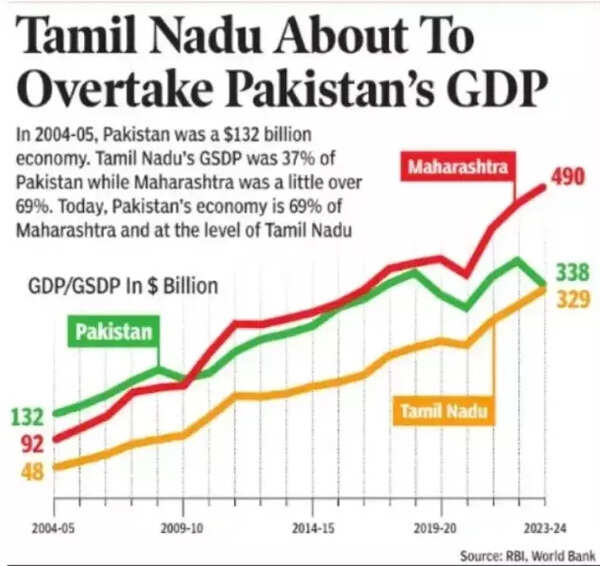Pakistan may not want to go to the world with a ‘begging bowl’, but the fact remains that its economy is in dire straits. During a recent address, Pakistan Prime Minister Shehbaz Sharif acknowledged the country’s extremely poor economic condition and emphasised that the world does not want it to come to it with a ‘begging bowl’. He said Pakistan needs to focus on international investments rather than financial assistance.However, seeking bailout packages is not new for Pakistan. It has a long history of asking for loans and funds from external institutions and countries, and doing little to improve its economic indicators. Recently, Pakistan’s National Accounts Committee said that the country’s GDP growth fell short of official projections for FY 2024-25, achieving only 2.68 per cent growth compared to the targeted 3.6 per cent.Pakistan’s economic recovery remains delicate as it works under a $7 billion International Monetary Fund programme. The conditions of this financial package necessitate structural changes, including increased electricity rates and additional taxation measures.
Also Read | Explained in charts: India to become 4th largest world economy soon. What’s the road ahead to No.3 spot?Pakistan aims to obtain external commercial funding amounting to $4.9 billion during fiscal year 2025-26. The government’s aim is to secure $2.64 billion in short-term commercial bank borrowings.Pakistan’s economy faces multiple challenges and risks, and India’s punitive measures post the Pahalgam terror attack are not making it easier for Islamabad to emerge stronger.Indus Waters Treaty Blow Impact ShowingThe agriculture sector, which provides employment to about 40% of the labour force, is facing substantial disturbances following India’s move to suspend the Indus Waters Treaty.The kharif (summer crops) planting period in Pakistan faces significant challenges due to severely reduced water levels at its crucial dams – Mangla on river Jhelum and Tarbela on the Indus river. Additionally, there has been an abrupt reduction in Chenab river flow following India’s water regulation after the Pahalgam terror incident. The water crisis could worsen during the early kharif sowing period this month. According to recent data from Pakistan’s Indus River System Authority (IRSA), the country currently has a 21% deficit in water flow, whilst the two primary dams show approximately 50% reduction in live storage. These dams are vital for irrigation in Pakistan’s Punjab and Sindh provinces, as well as for hydroelectric power generation.The IRSA’s recent evaluation of water availability for summer sowing during May-Sept highlighted concerns about reduced water flow in river Chenab at Marala, attributing it to India’s limited supply, which would affect early kharif season operations, according to a TOI report.Also Read | India’s big crackdown! 20 export houses under scanner for illicit Pakistan trade using UAE route; trade-based money laundering suspectedThe authority announced a 21% overall deficit and instructed reservoir management and irrigation monitoring bodies to carefully manage water resources from storage facilities, considering the “crisis created by Indian short supplies in Chenab river”.Whilst monsoon in the catchment region could potentially improve conditions by next month, Pakistan’s agricultural activities will be significantly influenced by India’s management of water flow through its limited storage facilities – Baglihar and Salal – situated on the Chenab in J&K.

Tamil Nadu About To Overtake Pakistan’s GDP
Officials believe India’s suspension of the Indus Waters Treaty could significantly impact Pakistan’s ability to handle flood situations during peak flow periods when monsoon affects the Indus river system’s catchment areas, with a substantial portion situated within India. Agricultural activities in Pakistan’s Punjab and Sindh provinces are entirely reliant on irrigation channels connected to the Indus river network, which receives nearly all its water from the western rivers – Indus, Jhelum and Chenab.Targeting Pakistan’s Funding SourcesIndia aims to restrict Pakistan’s access to funds in its ongoing efforts against state-sponsored terrorism from across the border. Following its opposition to Pakistan’s IMF bailout package, India intends to challenge forthcoming World Bank loans earmarked for Pakistan as well.Furthermore, India intends to approach the Financial Action Task Force (FATF), the global financial crime watchdog, seeking Pakistan’s return to its ‘grey list’.Pakistan’s exit from the FATF grey list in 2022 had improved its credibility with financial institutions, which was vital for its economically challenged situation. If FATF puts Pakistan back on the ‘grey list’, it will make it more difficult for the country to get investment.Also Read | ‘Big ban’ actions: How India is shunning Pakistan and its allies like Turkey & Azerbaijan – top 5 measuresIMF’s Strong Warning to PakistanEven as it grapples with agriculture crises, Pakistan has also been issued a strong warning by the IMF over its bailout package. The IMF has substantially increased its loan programme prerequisites for Pakistan. The IMF has outlined 11 new conditions for Pakistan to secure continued financial support, including passing a Rs 17.6 trillion federal budget aligned with IMF targets by June 2025 and implementing agricultural income tax reforms across all provinces.Other key requirements include publishing a governance reform plan, preparing a long-term financial sector strategy, rebasing electricity tariffs by July, and adjusting gas tariffs by February 2026. The IMF also demands permanent legislation for a captive power levy, removal of the cap on a debt servicing surcharge, phasing out tax incentives in special technology zones by 2035, liberalizing used car imports, and allocating Rs 1.07 trillion for development spending.











